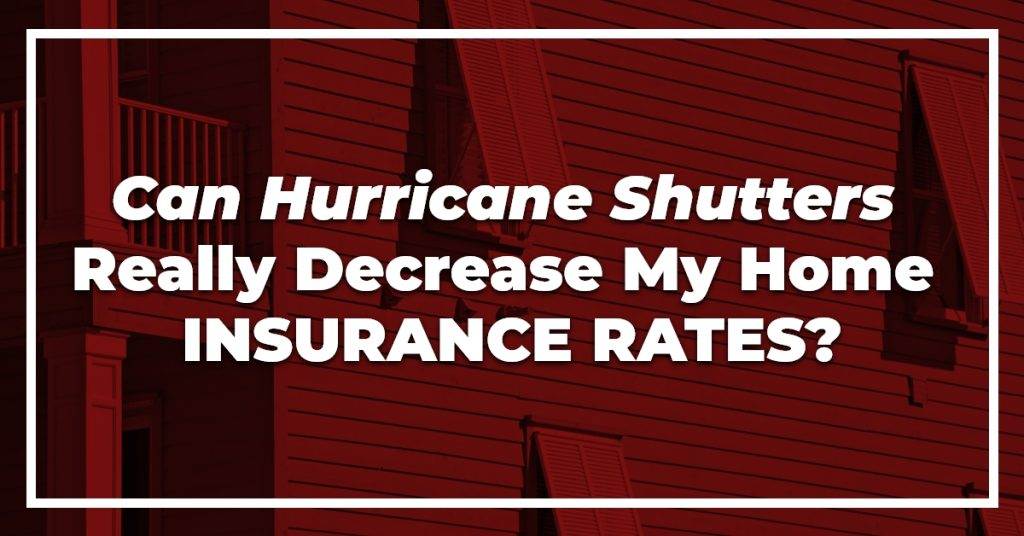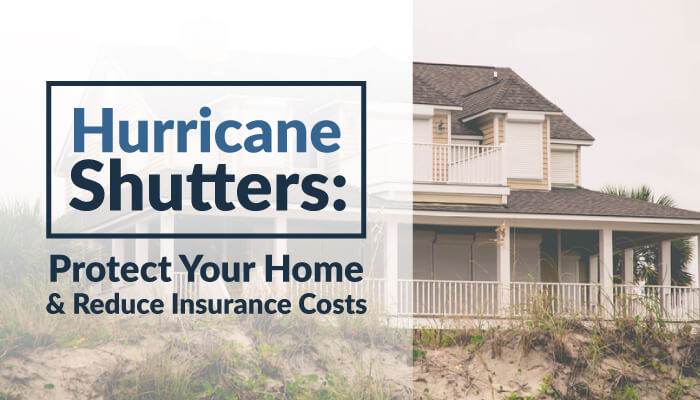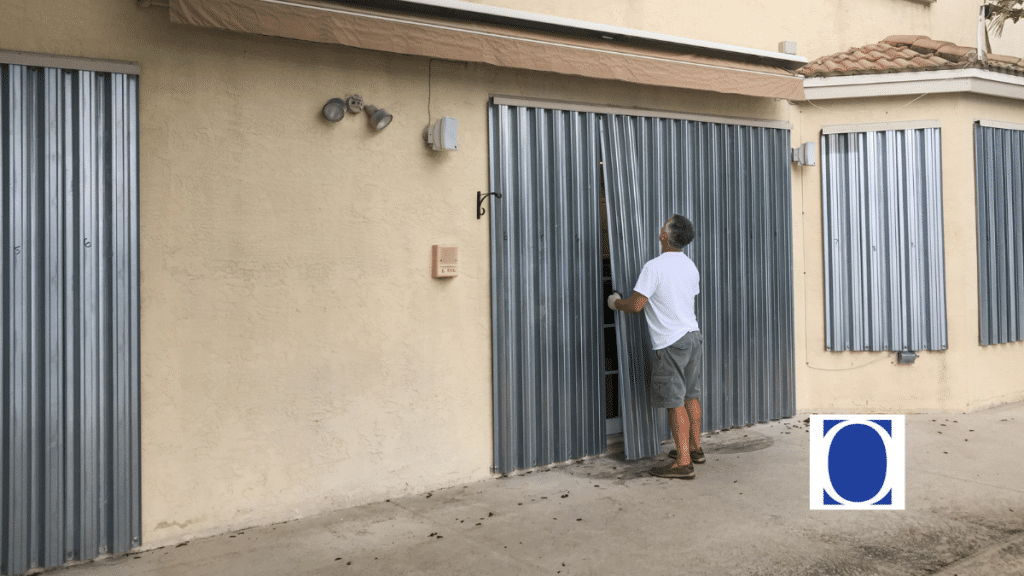In this article, we will be discussing whether hurricane shutters can actually lower your insurance premiums. We will explore the benefits of having hurricane shutters installed on your property and how they can potentially reduce the risk of damage during a storm. Additionally, we will look at the various factors that insurance companies consider when determining insurance rates and whether having hurricane shutters could make a difference. So, if you’re curious about the relationship between hurricane shutters and insurance costs, keep reading to find out more.

This image is property of www.reliantroofing.com.
Understanding Hurricane Shutters
Hurricane shutters are an essential component of a home’s defense against the destructive forces of hurricanes and tropical storms. These shutters are designed to protect windows and doors from high winds, flying debris, and torrential rain. They provide an added layer of security to homeowners, safeguarding their property and keeping them safe during severe weather events.
Different types of hurricane shutters
There are several types of hurricane shutters available on the market today, each offering its own set of benefits and features. The most common types of hurricane shutters are:
-
Accordion shutters: These shutters fold like an accordion and are permanently attached to the sides of windows or doors. They are easy to operate and can be quickly deployed when a storm is approaching.
-
Roll-up shutters: These shutters are installed above the windows or doors and can be rolled up or down as needed. They are operated by a motor or crank, making them convenient and efficient.
-
Colonial shutters: These are decorative shutters that attach to the sides of windows and can be closed and secured during a storm. They add a touch of elegance to the exterior of a home while providing protection.
-
Storm panels: These are made of steel, aluminum, or polycarbonate and are attached to the exterior of windows and doors using tracks or bolts. Storm panels are durable and offer excellent protection against high winds and flying debris.
How hurricane shutters work
The primary purpose of hurricane shutters is to prevent or minimize the damage caused by high winds, airborne projectiles, and heavy rain. When properly installed, hurricane shutters create a barrier between the interior of a home and the outside elements.
During a hurricane, the strong winds can put immense pressure on windows and doors, causing them to shatter. Once a window or door is broken, winds and rain can enter the home, leading to severe structural damage and flooding. By installing hurricane shutters, homeowners can protect their property and reduce the risk of costly repairs.
Benefits of installing hurricane shutters
Installing hurricane shutters offers several benefits to homeowners, both in terms of safety and financial security. Some of the key benefits of hurricane shutters include:
-
Protection against wind and debris: Hurricane shutters are designed to withstand high winds and flying debris, offering effective protection for windows and doors. By preventing these vulnerable areas from being compromised, homeowners can minimize the risk of structural damage to their property.
-
Enhanced home security: Hurricane shutters provide an added layer of security against intruders, offering peace of mind when homeowners are away or during times of evacuation.
-
Increased energy efficiency: Hurricane shutters can also help to reduce energy costs by blocking out heat and UV rays from the sun. This can result in lower cooling expenses during hot summer months.
-
Noise reduction: Hurricane shutters serve as a barrier against external noise and can help to create a more peaceful and quiet living environment.
Insurance and Hurricane Shutters
Insurance coverage for hurricane damage
When it comes to protecting a home against hurricane damage, insurance coverage plays a vital role. Homeowners insurance typically covers damage caused by hurricanes, including wind damage, wind-driven rain, and damage from falling trees or debris. However, the extent of coverage and policy limits can vary depending on the insurance provider and the specifics of the policy.
Most homeowners insurance policies cover wind damage, but it is essential to review the policy carefully to understand the exclusions and limitations. Some policies may impose higher deductibles for hurricane damage or require the addition of a separate windstorm policy.
Factors influencing insurance premiums
Insurance premiums for homes located in hurricane-prone areas are generally higher than those located in regions with less severe weather risks. Insurance companies calculate premiums based on various factors, including the location of the home, proximity to the coast, construction materials, and the presence of protective measures such as hurricane shutters.
Impacts of hurricane shutters on insurance rates
Installing hurricane shutters can have a positive impact on insurance rates. Insurance companies often offer discounts and incentives to homeowners who take proactive measures to protect their property against hurricanes and other natural disasters. By installing hurricane shutters, homeowners demonstrate their commitment to minimizing the risk of damage and loss, which can result in lower insurance premiums.
The actual amount of the discount will vary depending on the insurance company and the specific policy. Homeowners should contact their insurance provider to inquire about any available discounts or reduced rates for installing hurricane shutters.
Effectiveness of Hurricane Shutters
Research studies on hurricane shutters
Numerous research studies have been conducted to evaluate the effectiveness of hurricane shutters in reducing property damage during severe storms. The general consensus among these studies is that properly installed and maintained hurricane shutters can significantly reduce the risk of damage to windows and doors.
One study conducted by the Insurance Institute for Business & Home Safety (IBHS) found that homes protected by hurricane shutters experienced significantly less damage and were better able to withstand the impact of hurricanes compared to homes without shutters.
Real-life examples of hurricane shutters in action
There have been several instances where the effectiveness of hurricane shutters has been demonstrated in real-life situations. For example, during Hurricane Andrew in 1992, many homes in Florida equipped with hurricane shutters emerged relatively unscathed, while nearby homes without shutters suffered severe damage.
Similarly, in more recent hurricanes such as Hurricane Irma in 2017, homeowners who had installed hurricane shutters reported minimal damage to their windows and doors, even in areas where high winds and flying debris were prevalent.
Comparing damage costs with and without shutters
Research has shown that the installation of hurricane shutters can lead to significant cost savings in terms of property damage and insurance claims. According to a study conducted by the IBHS, homes with hurricane shutters experienced 40% less damage compared to homes without shutters.
By reducing the risk of window and door damage, homeowners can avoid costly repairs and insurance claims, resulting in potential savings of thousands of dollars. When factoring in the potential insurance premium discounts for having hurricane shutters, the financial benefits become even more significant.
Installation and Maintenance of Hurricane Shutters
Professional installation process
While some homeowners may choose to install hurricane shutters themselves, it is recommended to hire a professional for proper and secure installation. Professional installation ensures that the shutters are correctly aligned, fully functional, and well-maintained, maximizing their effectiveness during a hurricane.
During the professional installation process, the technician will assess the home’s windows and doors, take precise measurements, and recommend the most suitable type of hurricane shutters. They will then install the shutters using high-quality materials and ensure that they are secured firmly in place.
DIY installation considerations
For homeowners who are confident in their DIY skills, installing hurricane shutters can be a viable option. However, it is crucial to follow the manufacturer’s instructions carefully and use the appropriate tools and materials.
It is also essential to ensure that the shutters are securely fastened and properly aligned to provide effective protection against high winds and debris. Homeowners should be aware of any building codes or regulations that may govern the installation of hurricane shutters in their area.
Regular maintenance tips for long-term functionality
To ensure the long-term functionality of hurricane shutters, regular maintenance is necessary. Here are some maintenance tips to keep in mind:
-
Inspect the shutters: Regularly inspect the shutters for any signs of damage or wear. Look for cracks, bends, or loose components. If any issues are detected, promptly repair or replace the damaged parts.
-
Clean the shutters: Clean the shutters regularly to remove dirt, debris, and salt buildup. Use a gentle cleanser and a soft cloth to avoid scratching the surface.
-
Lubricate moving parts: Lubricate the hinges, tracks, and other moving parts of the shutters to ensure smooth operation. Use a silicone-based lubricant for optimal results.
-
Test the shutters: Test the shutters periodically to ensure that they are functioning correctly. Open and close them several times to check for any abnormalities or obstructions.
By following these maintenance tips, homeowners can ensure that their hurricane shutters remain in optimal condition and continue to provide effective protection for years to come.

This image is property of pcshuttersusa.com.
Cost-Benefit Analysis of Hurricane Shutters
Cost of purchasing and installing shutters
The cost of purchasing and installing hurricane shutters can vary depending on several factors, including the size and number of windows and doors, the type of shutters chosen, and the region’s labor rates. On average, homeowners can expect to pay between $200 and $1,500 per window or door for the supply and installation of hurricane shutters.
While the upfront cost may seem significant, it is important to consider the long-term benefits and potential cost savings. By protecting windows and doors from damage, homeowners can avoid expensive repairs and reduce insurance premiums over time.
Potential savings on insurance premiums
Installing hurricane shutters can lead to substantial savings on insurance premiums. Many insurance companies offer discounts or reduced rates for homes equipped with hurricane shutters or other protective measures.
The exact amount of the discount will vary depending on the insurance provider and the specific policy. Homeowners should consult with their insurance agent to determine the potential savings they can expect by installing hurricane shutters.
Other financial benefits of hurricane shutters
In addition to potential insurance premium savings, hurricane shutters offer other financial benefits. By preventing or minimizing damage to windows and doors, homeowners can avoid expensive repairs or replacements. This can result in significant cost savings, especially in areas prone to frequent hurricanes or severe storms.
Furthermore, the enhanced security provided by hurricane shutters can potentially reduce the risk of burglary or vandalism, leading to further financial savings in terms of stolen or damaged possessions.
Building Code Requirements and Hurricane Shutters
Building code regulations for hurricane-prone areas
In areas prone to hurricanes and severe weather, building codes often include specific requirements for the installation and use of hurricane shutters. These regulations aim to ensure that homes are adequately protected and can withstand the forces associated with high winds and flying debris.
Local building codes may specify the type of hurricane shutters that are permissible, as well as specific installation guidelines. It is essential for homeowners to research and comply with these regulations when installing hurricane shutters.
Compliance with code requirements
To ensure compliance with building codes, homeowners should consult with local building authorities or seek professional guidance. By following the code requirements, homeowners can ensure that their hurricane shutters are installed correctly and provide the intended protection.
Failure to comply with building code regulations can result in penalties and may also invalidate insurance coverage in the event of damage caused by a hurricane or severe storm.
Consequences of non-compliance
Non-compliance with building code requirements can have severe consequences for homeowners. In addition to the potential loss of insurance coverage, homeowners may face fines and legal liabilities for failing to adhere to the specified regulations.
Furthermore, homes that do not meet building code requirements may be more vulnerable to damage during hurricanes, putting not only the property at risk but also the safety of the occupants.

This image is property of hurricaneshutterpros.com.
Alternatives to Hurricane Shutters
Impact-resistant windows and doors
In addition to hurricane shutters, impact-resistant windows and doors provide an alternative option for protecting homes against severe weather. These windows and doors are constructed with a special layer of laminated glass that is designed to withstand high winds, flying debris, and impact.
Impact-resistant windows and doors offer several benefits, including enhanced security, noise reduction, and energy efficiency. However, they can be significantly more expensive than hurricane shutters and may require professional installation.
Storm panels as an alternative
Storm panels are another alternative to traditional hurricane shutters. These panels are made of steel, aluminum, or polycarbonate and are installed over windows and doors using tracks or bolts. Storm panels are durable and offer excellent protection against high winds and debris impact.
The main advantage of storm panels is their affordability, as they are generally less expensive than other hurricane protection options. However, they require more time and effort to install and remove, compared to other types of hurricane shutters.
Pros and cons of alternative options
While impact-resistant windows, doors, and storm panels offer viable alternatives to hurricane shutters, each option has its own set of pros and cons. Here are some factors to consider when deciding which option is best for your home:
-
Cost: Hurricane shutters generally offer a more cost-effective solution compared to impact-resistant windows and doors. Storm panels are the most affordable option, but they require more time and effort for installation.
-
Aesthetics: Impact-resistant windows and doors are designed to blend seamlessly with the overall architectural style of a home. Hurricane shutters and storm panels can add a decorative element, but they may not offer the same level of aesthetic appeal.
-
Maintenance: Impact-resistant windows and doors require minimal maintenance and do not require installation or removal. Hurricane shutters and storm panels may require regular maintenance and must be installed and removed manually.
-
Convenience: Impact-resistant windows and doors offer continuous protection without the need for manual installation. Hurricane shutters and storm panels require manual installation and removal, which can be time-consuming.
Considering these factors, homeowners should evaluate their specific needs, budget, and preferences when choosing between hurricane shutters, impact-resistant windows and doors, or storm panels.
Additional Measures for Hurricane Protection
Reinforcing roof and walls
In addition to installing hurricane shutters or other protective measures for windows and doors, reinforcing the roof and walls of a home can further enhance its ability to withstand hurricane forces.
Roofs should be inspected regularly to ensure they are structurally sound and properly secured. Loose or damaged roofing materials should be repaired or replaced promptly. Reinforcing walls may involve the installation of hurricane straps, which can help to keep the roof connected to the walls during a storm.
Taking steps to minimize hurricane damage
While hurricane shutters and other protective measures are essential, there are additional steps homeowners can take to further minimize hurricane damage:
-
Secure outdoor items: Remove or secure any outdoor furniture, equipment, or decorative items that could become projectiles during high winds.
-
Trim trees and shrubs: Regularly trim trees, shrubs, and branches that could potentially fall and cause damage during a hurricane.
-
Create a disaster preparedness plan: Develop a comprehensive disaster preparedness plan that includes evacuation routes, emergency contacts, and supplies.
-
Monitor weather forecasts: Stay informed about weather conditions and follow the instructions and recommendations of local authorities.
By taking these additional measures, homeowners can further reduce the risk of damage and increase the overall resilience of their homes.

This image is property of www.oyerinsurance.com.
Community and Government Initiatives
Availability of subsidies or grants for hurricane protection
In recognition of the importance of hurricane protection, many communities and government entities offer subsidies or grants to homeowners for the installation of protective measures such as hurricane shutters. These programs aim to promote resilience and encourage homeowners to take proactive steps in safeguarding their homes.
Homeowners should research the availability of such programs in their area and take advantage of any financial assistance that may be available.
Incentives for installation of hurricane shutters
In addition to subsidies and grants, some insurance providers offer incentives or discounts for homeowners who install hurricane shutters or other protective measures. These incentives can further reduce the cost of installing and maintaining hurricane shutters while providing additional financial benefits.
It is recommended for homeowners to contact their insurance provider to inquire about any available incentives or discounts for installing hurricane shutters.
Legislation promoting resilience measures
In recent years, there has been an increased focus on legislation promoting resilience measures in hurricane-prone areas. These measures aim to enhance building codes, encourage the use of hurricane-resistant materials, and promote the installation of protective measures such as hurricane shutters.
Legislation promoting resilience measures plays a crucial role in ensuring the safety and security of homeowners in hurricane-prone regions. By complying with these regulations, homeowners can contribute to the overall resilience of their community and reduce the risk of damage and loss during severe weather events.
Conclusion
Hurricane shutters are a critical component of a home’s defense against the devastating forces of hurricanes and tropical storms. Not only do they provide effective protection against high winds and flying debris, but they can also lead to significant financial benefits, including potential savings on insurance premiums and reduced repair costs.
Furthermore, the installation of hurricane shutters demonstrates a commitment to protecting one’s property and increasing overall resilience. By investing in hurricane shutters, homeowners can play an active role in safeguarding their homes, reducing insurance risks, and contributing to the overall safety and security of their community.
When considering hurricane protection options, it is essential for homeowners to evaluate their specific needs, budget, and preferences. Whether choosing hurricane shutters, impact-resistant windows and doors, or storm panels, the primary objective should be to ensure the safety and security of the home and its occupants during severe weather events.

This image is property of www.houselogic.com.
